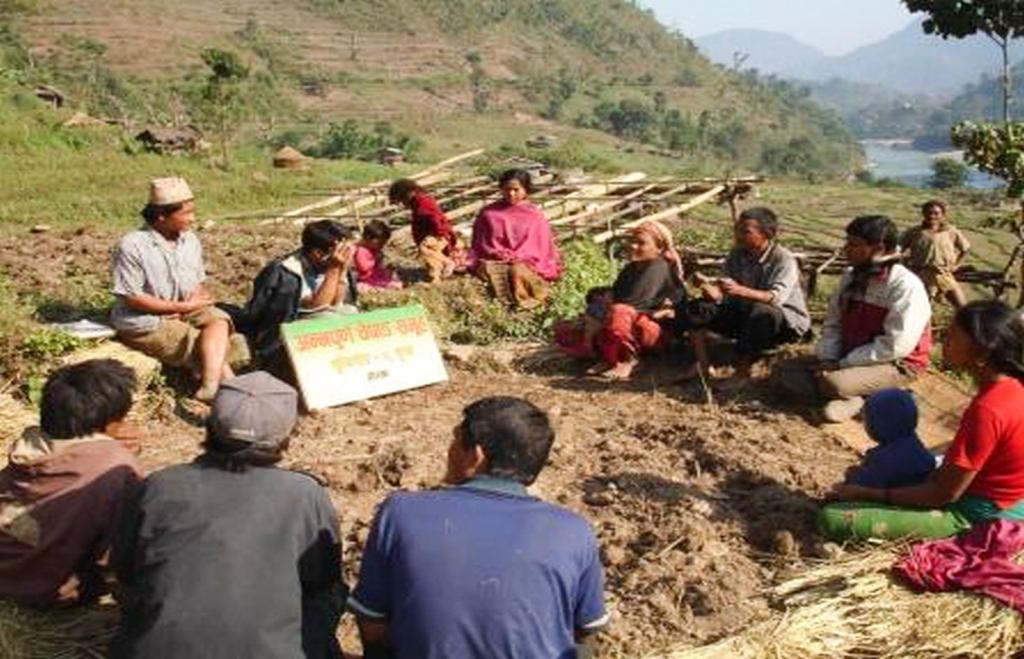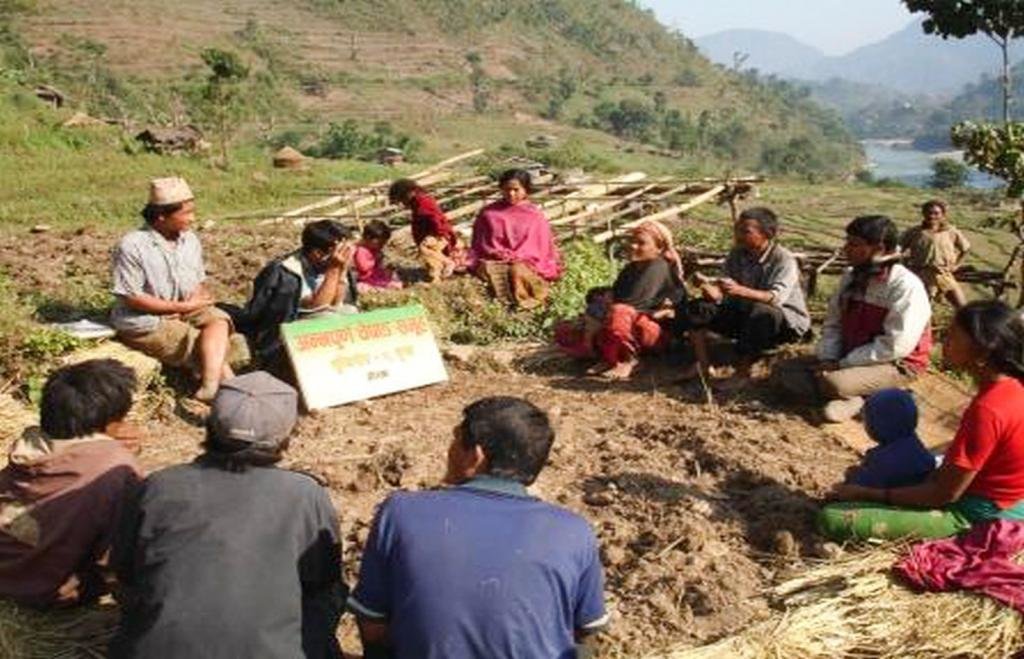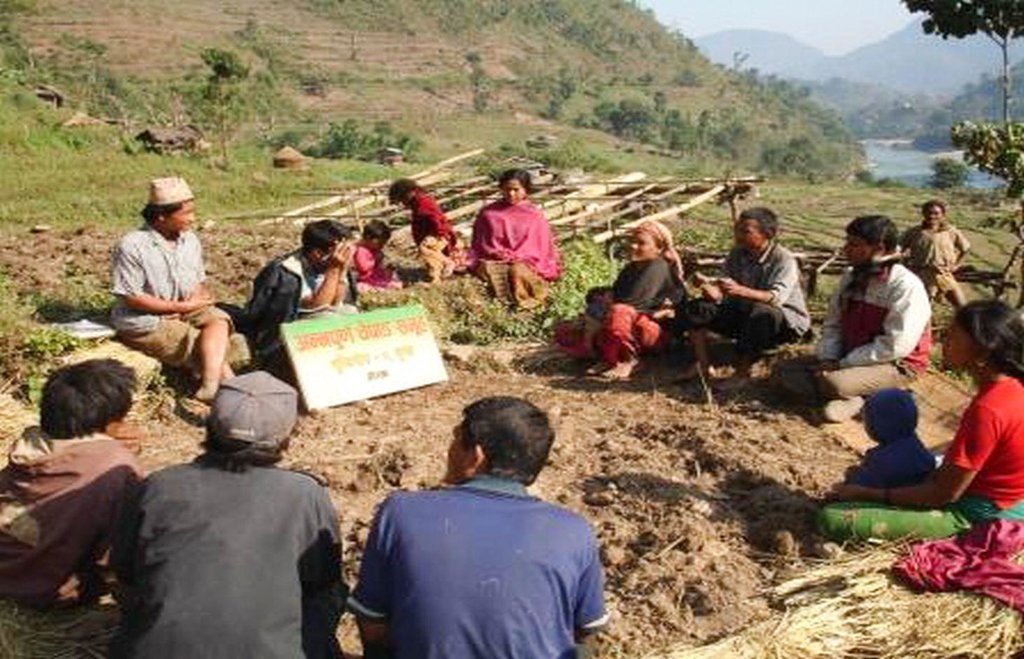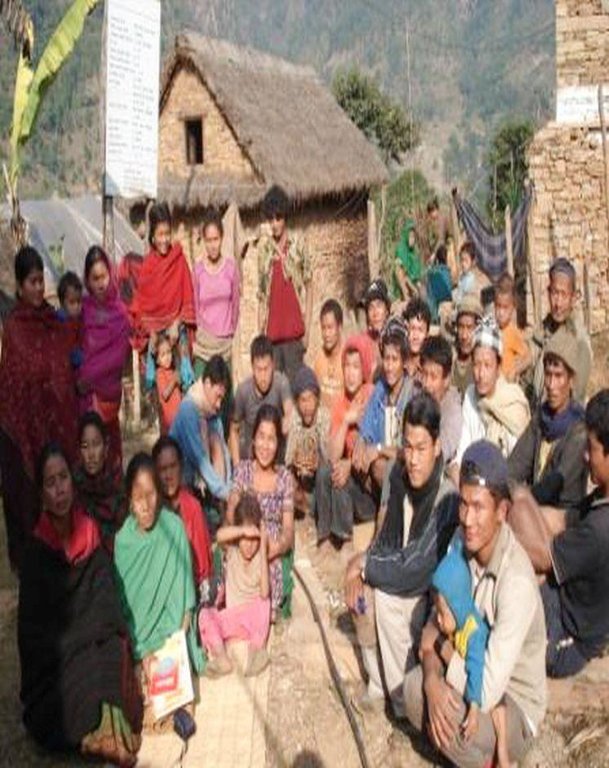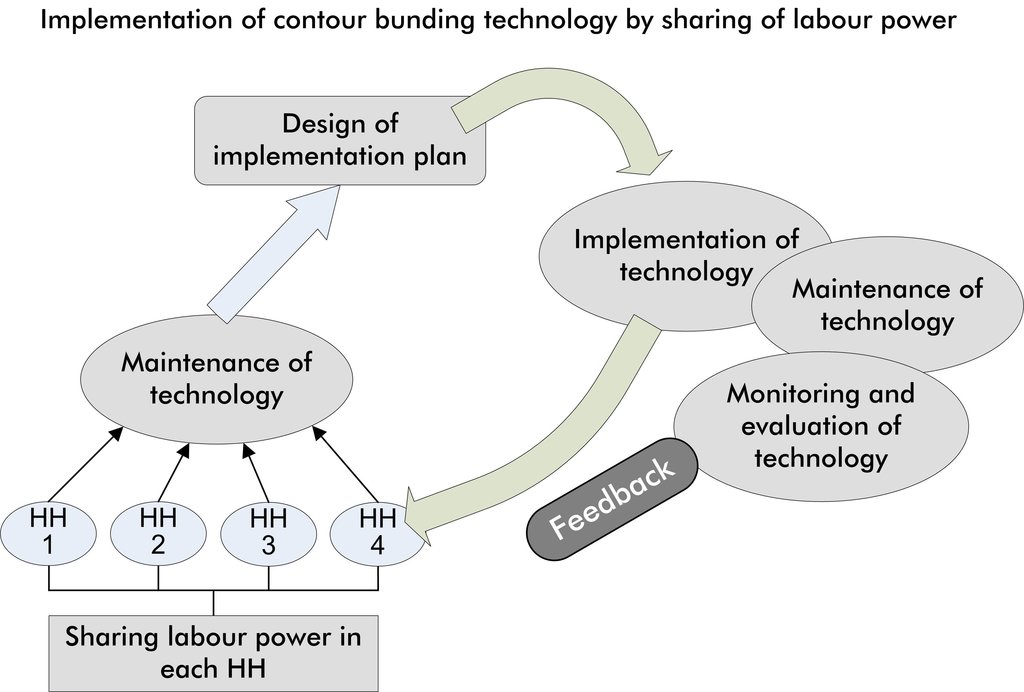Sharing labour to implement contour bunding [Непал]
- Создание:
- Обновить:
- Составитель: Shreedip Sigdel
- Редактор: –
- Рецензент: Fabian Ottiger
Janasakti aadanpradhan gari bhajo halne padhiti karanwanan (Main contributor: Bir Bahadur Tamang, LI-BIRD)
approaches_2604 - Непал
Просмотреть разделы
Развернуть все Свернуть все1. Общая информация
1.2 Контактные данные специалистов и организаций, участвующих в описании и оценке Подхода
Специалист по УЗП:
Tamanag Bir Bahadur
+977 61 526834 (0); 9746005992 (M)
btamang@libird.org
LI-BIRD, Gairapatan, Pokhara, P.O. Box 324
Непал
Название организации (-ий), содействовавших документированию/оценке Подхода (если применимо)
ICIMOD International Centre for Integrated Mountain Development (ICIMOD) - НепалНазвание организации (-ий), содействовавших документированию/оценке Подхода (если применимо)
Local Initiatives for Biodiversity, Research, and Development (LI-BIRD) - Непал1.3 Условия, регламентирующие использование собранных ВОКАТ данных
Когда были собраны данные (на местах)?
01/03/2013
Составитель и ответственный/-ые специалист(-ы) согласны с условиями, регламентирующими использование собранных ВОКАТ данных:
Да
2. Описание Подхода УЗП
2.1 Краткое описание Подхода
Members of a community can work together to help prevent soil erosion and increase productivity by working collectively to establish contour bunds.
2.2 Подробное описание Подхода
Подробное описание Подхода:
Aims / objectives: Over generations, the ethnic minorities of Nepal, who practice fireless shifting cultivation, known as 'gujultyaune', have successfully used contour bunding to control soil erosion, promote water retention, and increase crop production. Contour bunding is a proven sustainable land management practice in areas where the soil productivity of marginal, sloping, and hilly lands is very low. While it is both low cost and simple to implement, it does have the drawback that establishing contour bunds is very labour intensive. When members of a community work together to establish contour bunds the whole village can benefit.
Methods: By working collectively, a community can establish contour bunds that will benefit everyone and not individual farmers alone. The first step is to plan a course of action and to select the sites. Members of the community, who are thoroughly familiar with the landscape that the community inhabits, get together to discuss where the contour bunding will be most successful and benefit the greatest number of farmers. This planning phase is best carried out during the dry season before the rains begin. Once the sites are selected, everyone participates in the slashing of materials on the shifting cultivation lands. After the slashed materials have been allowed to dry for some weeks, the community assembles to gather these into rows that will form the bunds. Every member of the community participates according to their ability.
Stages of implementation: The steps for sharing labour to establish contour bunds in a community which practises shifting cultivation can be summarized as follows:
• The community meets to finalize a plan of action.
• Everyone participates in the slashing of shifting cultivation plots.
• The slashed materials are collected and allowed to dry.
• The slashed materials are formed into rows that will constitute the bunds.
• Everyone participates and eventually, the land between the bunds is prepared for the cultivation of crops.
2.3 Фотографии, иллюстрирующие Подход
2.5 Страна/ регион/ место, где применялся Подход
Страна:
Непал
Более точная привязка места:
Tanahun, Gorkha District
2.7 Тип Подхода
- традиционная/ местная система землепользования, используемая коренным населением
2.8 Каковы цели/ задачи Подхода
The Approach focused mainly on SLM with other activities (increasing crop production)
To increase crop yields and help to prevent soil erosion in communities that practise shifting cultivation by getting the whole community to participate in establishing contour bunds.
The SLM Approach addressed the following problems: The main stumbling blocks to this approach are a gap in the sharing of traditional knowledge, lack of the money needed for investment, community conflicts over allocation of resources, and overall poor social cohesiveness.
2.9 Условия содействующие применению Технологии/ Технологий в рамках Подхода или затрудняющие его
Наличие/ доступность финансовых ресурсов и услуг
- затрудняют
Individual farmers do not have sufficient resources to
implement the technology on their own
Treatment through the SLM Approach: By sharing labour everyone benefits without any outlay by individual farmers
Институциональные условия
- затрудняют
Groups are not aware of how to mobilize for community empowerment
Treatment through the SLM Approach: Raise level of awareness and enhance capacity on how to mobilize the community and on how to institutionalize the process
Осведомленность в области УЗП, доступность технической поддержки
- затрудняют
Traditional knowledge on contour bunding is not shared
Treatment through the SLM Approach: Technical information is shared when the technology is implemented
3. Участие и распределение ролей заинтересованных сторон
3.1 Заинтересованные стороны, участвующие в реализации Подхода и их роли
- местные землепользователи/ местные сообщества
This technology is straightforward; the community of land users can implement it without external input. This is a sustainable land management practice in areas where shifting cultivation is practised. These areas have typically been inhabited by poor and marginal groups like the Chepang, Magar, Dalit, and Gurung groups.
3.2 Участие местных землепользователей/ местных сообществ на разных стадиях реализации Подхода
| Участие местных землепользователей/ местных сообществ | Перечислите участников и опишите их вовлеченность | |
|---|---|---|
| инициирование/ мотивация | самоорганизация | Demand created by the community |
| планирование | интерактивное | Through discussions the whole community is involved in deciding what sites are to be contoured and how the bunding technology is to be implemented. |
| выполнение | самоорганизация | The whole community is involved in planning the sites, slashing the biomass, and forming the contour bunds. |
| мониторинг/ оценка | нет | |
| Research | нет |
3.3 Схема реализации (если имеется)
Описание:
Each household (HH) contributes labour and the community works together to implement contour bunding.
Автор:
AK Thaku
3.4 Принятие решений по выбору Технологии/ Технологий УЗП
Укажите, кто принимал решение по выбору применяемой Технологии/ Технологий:
- исключительно землепользователи (по собственной инициативе)
Поясните:
The land users themselves decide on the technology during participatory discussions held in the community. This is a bottom-up approach
Decisions on the method of implementing the SLM Technology were made by by land users* alone (self-initiative / bottom-up). The land users themselves possess traditional knowledge on how the technology should be implemented. Since some farmers have a better grasp of the technology than others, the different methods are discussed and the community as a whole decides what method is to be used.
4. Техническая поддержка, повышение компетенций и управление знаниями
4.1 Повышение компетенций/ обучение
Проводилось ли обучение землепользователей/ других заинтересованных лиц?
Да
Укажите, кто проходил обучение:
- землепользователи
Тип обучения:
- обмен опытом между фермерами
- опытные участки
- общие собрания
4.2 Консультационные услуги
Есть ли у землепользователей возможность получать консультации?
Да
4.3 Институциональная (организационная) поддержка
В ходе реализации Подхода были ли организованы новые институциональные структуры или поддержаны уже существующие?
- нет
4.4 Мониторинг и оценка
Являются ли мониторинг и оценка частью Подхода?
Да
Комментарии:
bio-physical aspects were regular monitored by land users through measurements; indicators: Land users regularly monitor the organic matter and moisture content of the soil and establish plants in bunds
technical aspects were regular monitored by land users through measurements; indicators: Land users regularly monitor terrace formation and soil erosion
socio-cultural aspects were regular monitored by land users through observations; indicators: The community observes and comments on the degree to which contour bunding is implemented
economic / production aspects were regular monitored by land users through measurements; indicators: Land users note crop production and how it affects their cash income
area treated aspects were regular monitored by land users through measurements; indicators: Land users regularly monitor small patches used in shifting cultivation
no. of land users involved aspects were regular monitored by land users through observations; indicators: The whole community participates in observing how many people are involved
management of Approach aspects were regular monitored by land users through measurements; indicators: The whole community participates
There were few changes in the Approach as a result of monitoring and evaluation: Gradually, farmers in other communities are also adopting the same approach
5. Финансирование и внешняя материальная поддержка
5.1 Годовой бюджет мероприятий по УЗП в рамках Подхода
Если точный годовой бюжет неизвестен, укажите примерный диапазон затрат:
- < 2000
Комментарий (например, основные источники финансирования/ ключевые доноры):
Approach costs were met by the following donors: national non-government (LI-BIRD): 20.0%; local community / land user(s): 80.0%
5.2 Финансирование и внешняя материальная поддержка, предоставляемая землепользователям
Предоставлялась ли землепользователям финансовая/ материальная поддержка для применения Технологии /Технологий?
Нет
5.4 Кредитование
Предоставлялись ли в рамках Подхода кредиты на мероприятия УЗП?
Нет
6. Анализ влияния и заключительные положения
6.1 Влияние Подхода
Сумел ли Подход помочь землепользователям внедрить и поддерживать технологии УЗП?
- Нет
- Да, немного
- Да, умеренно
- Да, существенно
The approach was a good way of improving sloping land management.
Сумел ли Подход расширить возможности социально и экономически уязвимых групп?
- Нет
- Да, немного
- Да, умеренно
- Да, существенно
Moderate improvements were noted in Chepang, Magar, and Dalit households who benefited from this approach and improved their livelihoods
Did other land users / projects adopt the Approach?
- Нет
- Да, немного
- Да, умеренно
- Да, существенно
Those who implemented this approach cited improved soil fertility and the increased productivity of cash crops like legumes as a plus point.
Did the Approach lead to improved livelihoods / human well-being?
- Нет
- Да, немного
- Да, умеренно
- Да, существенно
these were mainly due to the increased earnings from the production of cash crops. Earnings were invested on daily needs which improved livelihoods.
Did the Approach help to alleviate poverty?
- Нет
- Да, немного
- Да, умеренно
- Да, существенно
Some poverty alleviation was noted among households who could increase the amount that they earned from cash crops. These households used the additional earnings on health care and education.
6.2 Основные причины, побуждающие землепользователей внедрять УЗП
6.3 Долгосрочная устойчивость мероприятий в рамках Подхода
Могут ли землепользователи самостоятельно (без внешней поддержки) продолжать применение того, что было реализовано в рамках Подхода?
- да
Если да, опишите как:
This is a community-based approach; each community formulates its own rules and regulations.
6.4 Сильные стороны/ преимущества Подхода
| Сильные стороны/ преимущества/ возможности по мнению составителя или других ключевых специалистов |
|---|
| Effectiveness (How to sustain/ enhance this strength: Improve the approach by continuing to work together to design, plan, and implement.) |
| Increases social cohesiveness (How to sustain/ enhance this strength: Continue to work collaboratively) |
| Decreased workload (How to sustain/ enhance this strength: Over time, the group decisions that work best no longer need to be revisited and less time is spent in discussions.) |
| Quick implementation of sloping land management measures (How to sustain/ enhance this strength: As the group learns to work together they can taking advantage of their synergy to quickly implement new measures.) |
| Empowerment (How to sustain/ enhance this strength: Encourage the community with technical backstopping) |
6.5 Слабые стороны/ недостатки Подхода и пути их преодоления
| Слабые стороны/ недостатки/ риски по мнению составителя или ответственных специалистов | Возможные пути их преодоления/снижения? |
|---|---|
| Some members contribute more than others | Each member of the group needs to be made aware of how they can contribute. |
7. Справочные материалы и ссылки
7.1 Методы сбора/источники информации
- выезды на места, полевые обследования
- опросы землепользователей
7.2 Ссылки на опубликованные материалы
Название, автор, год публикации, ISBN:
Indigenous knowledge of farmers in the shifting cultivation areas of Western Nepal, Regmi, BR; Aryal, KP; Subedi, A; Shrestha, PK; Tamang, BB (2001)
Ссылки и модули
Развернуть все Свернуть всеСсылки
Нет ссылок
Модули
Нет модулей


